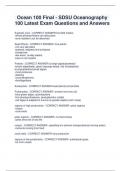Sdsu ocean 100 - Study guides, Class notes & Summaries
Looking for the best study guides, study notes and summaries about Sdsu ocean 100? On this page you'll find 54 study documents about Sdsu ocean 100.
All 54 results
Sort by

-
SDSU Ocean 100 Final SacramentoGrilo Latest Version Already Passed
- Exam (elaborations) • 39 pages • 2024
- Available in package deal
-
- $10.99
- + learn more
SDSU Ocean 100 Final SacramentoGrilo Latest Version Already Passed origin of earth • Supernova: death of a star (great explosion) • Supernova happened 4.6 bya, dust and gas flattens to a disk and spins faster due to gravity and solar nebula formed. • Solar Nebula: describes formation of Earth 4.5 bya • Nebula: gas cloud origin of oceans • volcanic explosion, H2O condensed and rained down for thousands of years to create oceans • icy comets hitting earth (respon...
SDSU Ocean 100 Final exam SacramentoGrilo complete stdy guide exam solution San Diego State University

-
SDSU Ocean 100 Final SacramentoGrilo Questions and Answers 100% Solved correctly
- Exam (elaborations) • 24 pages • 2024
- Available in package deal
-
- $7.99
- + learn more
origin of earth - Answer-• Supernova: death of a star (great explosion) • Supernova happened 4.6 bya, dust and gas flattens to a disk and spins faster due to gravity and solar nebula formed. • Solar Nebula: describes formation of Earth 4.5 bya • Nebula: gas cloud origin of oceans - Answer-• volcanic explosion, H2O condensed and rained down for thousands of years to create oceans • icy comets hitting earth (responsible for 1/2 of earths ocean water) origin of life - Answer-•...

-
SDSU Ocean 100 Final SacramentoGrilo Exam Questions And Answers 100% Verified
- Exam (elaborations) • 20 pages • 2024
- Available in package deal
-
- $13.49
- + learn more
SDSU Ocean 100 Final SacramentoGrilo Exam Questions And Answers 100% Verified Origin of earth - answer• Supernova: death of a star (great explosion) • Supernova happened 4.6 bya, dust and gas flattens to a disk and spins faster due to gravity and solar nebula formed. • Solar Nebula: describes formation of Earth 4.5 bya • Nebula: gas cloud origin of oceans - answer• volcanic explosion, H2O condensed and rained down for thousands of years to create oceans • icy comets hitting ...

-
SDSU Ocean 100 Final SacramentoGrilo Exam Questions And Answers 100% Verified
- Exam (elaborations) • 20 pages • 2024
- Available in package deal
-
- $13.49
- + learn more
SDSU Ocean 100 Final SacramentoGrilo Exam Questions And Answers 100% Verified Origin of earth - answer• Supernova: death of a star (great explosion) • Supernova happened 4.6 bya, dust and gas flattens to a disk and spins faster due to gravity and solar nebula formed. • Solar Nebula: describes formation of Earth 4.5 bya • Nebula: gas cloud origin of oceans - answer• volcanic explosion, H2O condensed and rained down for thousands of years to create oceans • icy comets hitting ...

-
SDSU Oceanography 100/Oceanography MRSC 100 /Oceanography 100 Occ /Ocean 100/Oceanography 100 Exams Package Deal Full Solutions Pack
- Package deal • 18 items • 2024
-
- $30.99
- + learn more
1 Exam (elaborations) SDSU Oceanography 100 Final Exam 2 Exam (elaborations) Oceanography-100 SDSU Exam 2 Solved 100% Correct 3 Exam (elaborations) Oceanography-100 SDSU Exam 1 Solved 100% Correct 4 Exam (elaborations) Oceanography MRSC 100 Exam 2 Study Guide with Complete Solutions 5 Exam (elaborations) Oceanography 100 Occ Exam Questions and

-
SDSU Ocean 100 Final SacramentoGrilo Exam Questions And Answers 100% Verified
- Exam (elaborations) • 20 pages • 2024
- Available in package deal
-
- $13.49
- + learn more
SDSU Ocean 100 Final SacramentoGrilo Exam Questions And Answers 100% Verified Origin of earth - answer• Supernova: death of a star (great explosion) • Supernova happened 4.6 bya, dust and gas flattens to a disk and spins faster due to gravity and solar nebula formed. • Solar Nebula: describes formation of Earth 4.5 bya • Nebula: gas cloud origin of oceans - answer• volcanic explosion, H2O condensed and rained down for thousands of years to create oceans • icy comets hitting ...

-
SDSU Ocean 100 Final SacramentoGrilo Exam Questions and Answers Graded A 2024
- Exam (elaborations) • 16 pages • 2024
- Available in package deal
-
- $13.49
- + learn more
origin of earth - • Supernova: death of a star (great explosion) • Supernova happened 4.6 bya, dust and gas flattens to a disk and spins faster due to gravity and solar nebula formed. • Solar Nebula: describes formation of Earth 4.5 bya • Nebula: gas cloud origin of oceans - • volcanic explosion, H2O condensed and rained down for thousands of years to create oceans • icy comets hitting earth (responsible for 1/2 of earths ocean water) origin of life - • 4.5 bya ...

-
ocean 100 SDSU Oceanography 100 exam 1 Final State Exam Questions and Answers
- Exam (elaborations) • 10 pages • 2024
-
- $12.99
- + learn more
ocean 100 SDSU Oceanography 100 exam 1 Final State Exam Questions and Answers science - CORRECT ANSWER-study of the physical, natural world through observations & experiments scientific method - CORRECT ANSWER-principles & empirical processes of discovery & demonstration considered characteristic of/ necessary for scientific investigation what are the steps of the scientific method? - CORRECT ANSWER-(1) observation (2) hypothesis (3) testing/experimenting (4) theory hypothesis - C...

-
Ocean 100 Final - SDSU Oceanography 100 Latest Exam Questions and Answers
- Exam (elaborations) • 8 pages • 2024
-
- $12.99
- + learn more
Ocean 100 Final - SDSU Oceanography 100 Latest Exam Questions and Answers Euphotic zone - CORRECT ANSWER-first 200 meters -where photosynthesis can take place -suns radiation can be absorbed Seed Plants - CORRECT ANSWER--true plants -not very abundant -grasses, eelgrass and surfgrass -mangroves -like warm, muddy waters -have a root system Protists - CORRECT ANSWER-a) large algae(seaweed) -brown algae(kelp), green (sponge weed), red (rhodophyta) b) phytoplankton(small algae) -most ...

Do you wonder why so many students wear nice clothes, have money to spare and enjoy tons of free time? Well, they sell on Stuvia! Imagine your study notes being downloaded a dozen times for $15 each. Every. Single. Day. Discover all about earning on Stuvia



